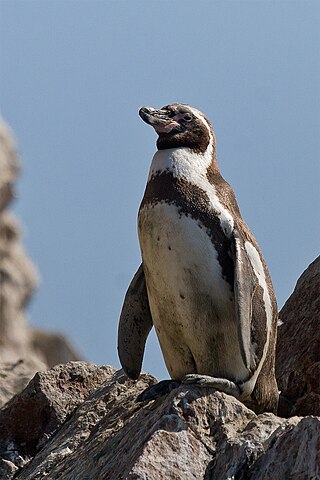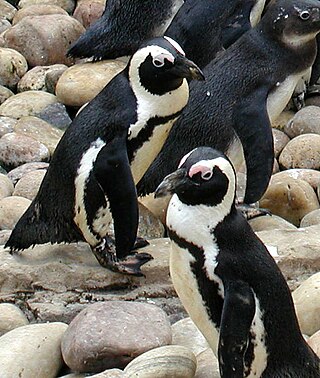
Penguins are a group of aquatic flightless birds from the order Sphenisciformes of the family Spheniscidae. They live almost exclusively in the Southern Hemisphere: only one species, the Galápagos penguin, is found north of the Equator. Highly adapted for life in the ocean water, penguins have countershaded dark and white plumage and flippers for swimming. Most penguins feed on krill, fish, squid and other forms of sea life which they catch with their bills and swallow whole while swimming. A penguin has a spiny tongue and powerful jaws to grip slippery prey.

The African penguin, also known as Cape penguin or South African penguin, is a species of penguin confined to southern African waters. Like all extant penguins, it is flightless, with a streamlined body and wings stiffened and flattened into flippers for a marine habitat. Adults weigh an average of 2.2–3.5 kg (4.9–7.7 lb) and are 60–70 cm (24–28 in) tall. The species has distinctive pink patches of skin above the eyes and a black facial mask. The body's upper parts are black and sharply delineated from the white underparts, which are spotted and marked with a black band.

The Humboldt penguin is a medium-sized penguin. It resides in South America, its range mainly contains most of coastal Peru. Its nearest relatives are the African penguin, the Magellanic penguin and the Galápagos penguin. The Humboldt penguin and the cold water current it swims in both are named after the explorer Alexander von Humboldt. The species is listed as vulnerable by the IUCN with no population recovery plan in place. The current population is composed of 32,000 mature individuals and is going down. It is a migrant species.

The Magellanic penguin is a South American penguin, breeding in coastal Patagonia, including Argentina, Chile, and the Falkland Islands, with some migrating to Brazil and Uruguay, where they are occasionally seen as far north as Espirito Santo. Vagrants have been found in El Salvador, the Avian Island in Antarctica, Australia, and New Zealand. It is the most numerous of the Spheniscus banded penguins. Its nearest relatives are the African penguin, the Humboldt penguin, and the Galápagos penguins. The Magellanic penguin was named after Portuguese explorer Ferdinand Magellan, who spotted the birds in 1520. The species is listed as being of Least Concern by the IUCN.

The banded penguins are penguins that belong to the genus Spheniscus. There are four living species, all with similar banded plumage patterns. They are sometimes also known as "jack-ass penguins" due to their loud locator calls sounding similar to a donkey braying. Common traits include a band of black that runs around their bodies bordering their black dorsal coloring, black beaks with a small vertical white band, distinct spots on their bellies, and a small patch of unfeathered or thinly feathered skin around their eyes and underdeveloped fluff sack that can be either white or pink. All members of this genus lay eggs and raise their young in nests situated in burrows or natural depressions in the earth.

Palaeospheniscus is an extinct genus of penguins belonging to the subfamily Palaeospheniscinae. These penguins are apparently not closely related to the modern genus Spheniscus.

Paraptenodytes is an extinct genus of penguins which contains two or three species sized between a Magellanic penguin and an emperor penguin. They are known from fossil bones ranging from a partial skeleton and some additional material in the case of P. antarcticus, the type specimen for the genus, and a single humerus in the case of P. brodkorbi. The latter species is therefore often considered invalid; a recent study considers it indeed valid, but distinct enough not to belong into Paraptenodytes. The fossils were found in the Santa Cruz and Chubut Provinces of Patagonia, Argentina, in the Gaiman, Monte León and Santa Cruz Formations of Early to Middle Miocene age. Later occurrences are apparently from Late Miocene or possibly even Early Pliocene deposits.
Inguza predemersus is an extinct species of penguin. It was formerly placed in the genus Spheniscus and presumed to be a close relative of the African penguin, but after its well-distinct tarsometatarsus was found, it was moved into its present monotypic genus. The known fossils specimens were found in Late Pliocene rocks in a quarry at Langebaanweg, South Africa, from about 5 million years ago.

Cabo de Hornos National Park is a protected area in southern Chile that was designated a Biosphere Reserve by UNESCO in 2005, along with Alberto de Agostini National Park. The world's southernmost national park, it is located 12 hours by boat from Puerto Williams in the Cape Horn Archipelago, which belongs to the Commune of Cabo de Hornos in the Antártica Chilena Province of Magallanes y Antártica Chilena Region.

Atacamatitan is a genus of titanosaurian sauropod dinosaurs from the Late Cretaceous Tolar Formation of Chile.
Tereingaornis moisleyi, also referred to as Moisley's penguin, is a genus and species of extinct penguin from the Middle Pliocene of New Zealand. It was slightly smaller than the extant Fiordland crested penguin. It was described by Ron Scarlett in 1983 from fossil material found by William Moisley near Te Reinga Falls on the Wairoa River, in the Hawke's Bay Region of the North Island. Another specimen was found later at Waihi Beach, Hawera, on the South Taranaki Bight. The genus name Tereingaornis combines the name of the type locality with the Greek ornis ("bird"); the specific epithet honours the discoverer of the fossil.
Caleta Herradura Formation is a geologic formation of Late Miocene (Montehermosan) age, cropping out on the Mejillones Peninsula in northern Chile. The erosion at the Coastal Cliff of northern Chile have created particularly good exposures of Caleta Herradura Formation. The formation deposited in a half graben within Mejillones Peninsula. The formation rests nonconformably on the Jorgino Formation.

Paradolichopithecus is an extinct genus of cercopithecine monkey once found throughout Eurasia. The type species, P. arvernensis, was a very large monkey, comparable in size to a mandrill. The genus was most closely related to macaques, sharing a very similar cranial morphology. The fossils attributed to Paradolichopithecus are known from the Early Pliocene to the Early Pleistocene of Europe and Asia. The East Asian fossil genus Procynocephalus is considered by some to represent a senior synonym of Paradolichopithecus.

Spheniscus muizoni is an extinct species of banded penguins that lived during the early Late Miocene in what is now Peru, South America. The species, the earliest member of the extant genus, was described in 2007 by Ursula B. Göhlich based on fossils found in the fossiliferous Pisco Formation of the Pisco Basin, southwestern Peru.

Spheniscus megaramphus is an extinct species of penguin that lived during the Late Miocene South America. It is notable for being the largest known species of banded penguin, along with having a proportionally large beak.
The Tolar Formation is a Late Cretaceous to Paleocene-aged geological formation located in Chile.












